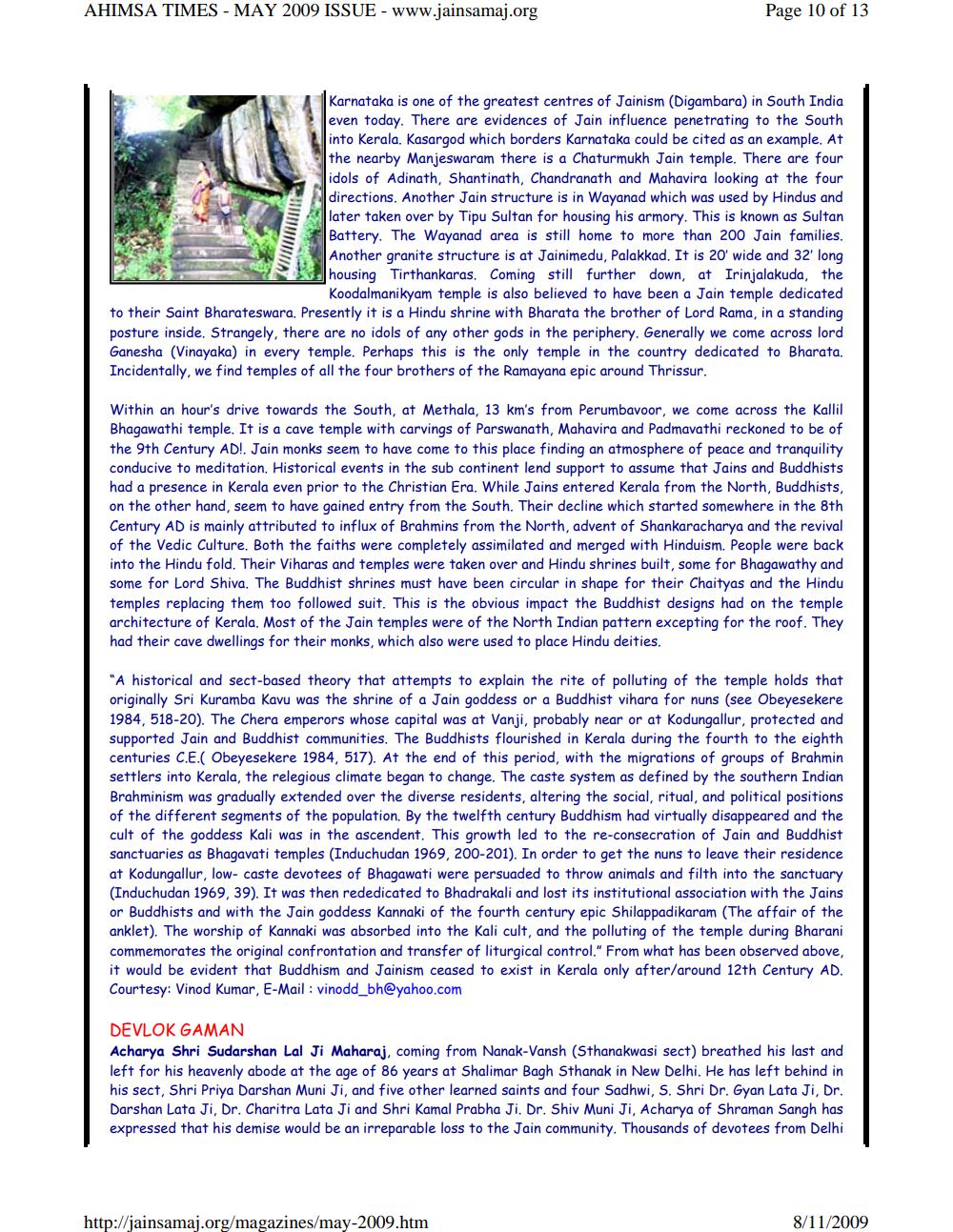________________
AHIMSA TIMES - MAY 2009 ISSUE - www.jainsamaj.org
Page 10 of 13
Karnataka is one of the greatest centres of Jainism (Digambara) in South India even today. There are evidences of Jain influence penetrating to the South into Kerala. Kasargod which borders Karnataka could be cited as an example, At the nearby Manjeswaram there is a Chaturmukh Jain temple. There are four idols of Adinath, Shantinath, Chandranath and Mahavira looking at the four directions. Another Jain structure is in Wayanad which was used by Hindus and later taken over by Tipu Sultan for housing his armory. This is known as Sultan Battery. The Wayanad area is still home to more than 200 Jain families. Another granite structure is at Jainimedu, Palakkad. It is 20' wide and 32' long housing Tirthankaras. Coming still further down, at Irinjalakuda, the
Koodalmanikyam temple is also believed to have been a Jain temple dedicated to their Saint Bharateswara. Presently it is a Hindu shrine with Bharata the brother of Lord Rama, in a standing posture inside. Strangely, there are no idols of any other gods in the periphery. Generally we come across lord Ganesha (Vinayaka) in every temple. Perhaps this is the only temple in the country dedicated to Bharata. Incidentally, we find temples of all the four brothers of the Ramayana epic around Thrissur.
Within an hour's drive towards the South, at Methala, 13 km's from Perumbavoor, we come across the Kallil Bhagawathi temple. It is a cave temple with carvings of Parswanath, Mahavira and Padmavathi reckoned to be of the 9th Century AD!. Jain monks seem to have come to this place finding an atmosphere of peace and tranquility conducive to meditation. Historical events in the sub continent lend support to assume that Jains and Buddhists had a presence in Kerala even prior to the Christian Era. While Jains entered Kerala from the North, Buddhists, on the other hand, seem to have gained entry from the South. Their decline which started somewhere in the 8th Century AD is mainly attributed to influx of Brahmins from the North, advent of Shankaracharya and the revival of the Vedic Culture. Both the faiths were completely assimilated and merged with Hinduism. People were back into the Hindu fold. Their Viharas and temples were taken over and Hindu shrines built, some for Bhagawathy and some for Lord Shiva. The Buddhist shrines must have been circular in shape for their Chaityas and the Hindu temples replacing them too followed suit. This is the obvious impact the Buddhist designs had on the temple architecture of Kerala. Most of the Jain temples were of the North Indian pattern excepting for the roof. They had their cave dwellings for their monks, which also were used to place Hindu deities.
"A historical and sect-based theory that attempts to explain the rite of polluting of the temple holds that originally Sri Kuramba kavu was the shrine of a Jain goddess or a Buddhist vihara for nuns (see Obeyesekere 1984, 518-20). The Chera emperors whose capital was at Vanji, probably near or at Kodungallur, protected and supported Jain and Buddhist communities. The Buddhists flourished in Kerala during the fourth to the eighth centuries C.E. Obeyesekere 1984, 517). At the end of this period, with the migrations of groups of Brahmin settlers into Kerala, the relegious climate began to change. The caste system as defined by the southern Indian Brahminism was gradually extended over the diverse residents, altering the social, ritual, and political positions of the different segments of the population. By the twelfth century Buddhism had virtually disappeared and the cult of the goddess Kali was in the ascendent. This growth led to the re-consecration of Jain and Buddhist sanctuaries as Bhagavati temples (Induchudan 1969, 200-201). In order to get the nuns to leave their residence at Kodungallur, low- caste devotees of Bhagawati were persuaded to throw animals and filth into the sanctuary (Induchudan 1969, 39). It was then rededicated to Bhadrakali and lost its institutional association with the Jains or Buddhists and with the Jain goddess Kannaki of the fourth century epic Shilappadikaram (The affair of the anklet). The worship of Kannaki was absorbed into the Kali cult, and the polluting of the temple during Bharani commemorates the original confrontation and transfer of liturgical control." From what has been observed above, it would be evident that Buddhism and Jainism ceased to exist in Kerala only after/around 12th Century AD. Courtesy: Vinod Kumar, E-Mail :
[email protected]
DEVLOK GAMAN Acharya Shri Sudarshan Lal Ji Maharaj, coming from Nanak-Vansh (Sthanakwasi sect) breathed his last and left for his heavenly abode at the age of 86 years at Shalimar Bagh Sthanak in New Delhi. He has left behind in his sect, Shri Priya Darshan Muni Ji, and five other learned saints and four Sadhwi, S. Shri Dr. Gyan Lata Ji, Dr. Darshan Lata Ji, Dr. Charitra Lata Ji and Shri Kamal Prabha Ji. Dr. Shiv Muni Ji, Acharya of Shraman Sangh has expressed that his demise would be an irreparable loss to the Jain community. Thousands of devotees from Delhi
http://jainsamaj.org/magazines/may-2009.htm
8/11/2009




